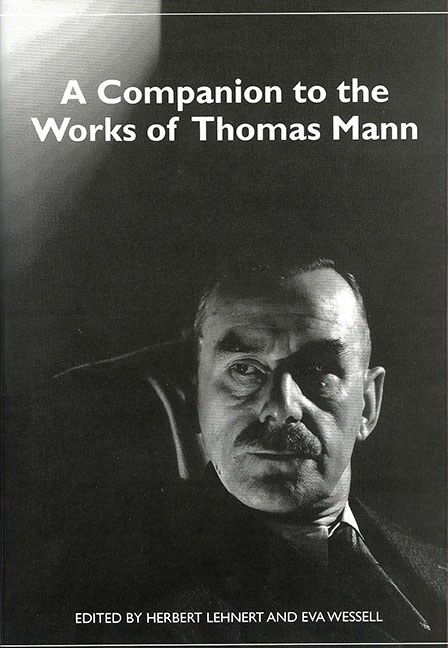Book contents
- Frontmatter
- Contents
- Foreword
- Thomas Mann's Works
- List of Abbreviations
- Introduction
- Thomas Mann's Beginnings and Buddenbrooks
- Art and Society in Thomas Mann's Early Novellas
- Love in Society: Thomas Mann's Early Stories
- “Death in Venice”
- “Mein ‘Friedrich’ — das ist was Anderes”: Thomas Mann's Unwritten Novel about Frederick the Great, King of Prussia
- Magic and Reflections: Thomas Mann's The Magic Mountain and His War Essays
- Thomas Mann's “Autobiographical” Stories
- Joseph and His Brothers
- Lotte in Weimar
- Thomas Mann's Late Politics
- “German” Music and German Catastrophe: A Re-Reading of Doktor Faustus
- The Gaze of Love, Longing, and Desire in Thomas Mann's “The Transposed Heads” and “The Black Swan”
- Felix Krull
- Female Identities and Autobiographical Impulses in Thomas Mann's Work
- Betrayed or Not Betrayed: A Testament?
- Thomas Mann's Comedies
- Notes on the Contributors
- Select Bibliography
- Index
Felix Krull
Published online by Cambridge University Press: 28 April 2017
- Frontmatter
- Contents
- Foreword
- Thomas Mann's Works
- List of Abbreviations
- Introduction
- Thomas Mann's Beginnings and Buddenbrooks
- Art and Society in Thomas Mann's Early Novellas
- Love in Society: Thomas Mann's Early Stories
- “Death in Venice”
- “Mein ‘Friedrich’ — das ist was Anderes”: Thomas Mann's Unwritten Novel about Frederick the Great, King of Prussia
- Magic and Reflections: Thomas Mann's The Magic Mountain and His War Essays
- Thomas Mann's “Autobiographical” Stories
- Joseph and His Brothers
- Lotte in Weimar
- Thomas Mann's Late Politics
- “German” Music and German Catastrophe: A Re-Reading of Doktor Faustus
- The Gaze of Love, Longing, and Desire in Thomas Mann's “The Transposed Heads” and “The Black Swan”
- Felix Krull
- Female Identities and Autobiographical Impulses in Thomas Mann's Work
- Betrayed or Not Betrayed: A Testament?
- Thomas Mann's Comedies
- Notes on the Contributors
- Select Bibliography
- Index
Summary
The Unfolding of the Novel
The history of the workBekenntnisse des Hochstaplers Felix Krull: Der Memoiren Erster Teil (Confessions of Felix Krull, Confidence Man: The Early Years, 1955) extends from its conception in 1905 to the final publication in 1954, a year before the author's death. It has often been compared with Goethe's Faust (1790–1832) — which also parallels and reflects the poet's development from youthful beginnings to old-age maturity — particularly since Krull's confessions emit other Faustian signals as well. But in its pompous tones it also parodies the venerable German educational autobiography such as Goethe's Dichtung und Wahrheit (Poetry and Truth, 1811–14). This genre typically records the development of the central character toward an all-around maturity. It is one of Mann's ironies that despite his constantly switching identities Felix never really changes.
Thomas Mann's first inspiration came from a more mundane source, the confessions of George Manolescu, a Romanian confidence man whose memoirs made the rounds of all Europe at the time of their publication in 1905. Mann's first notations for his novel date from 1906, a period when he was interested in the complexities of the alienated artist's existence in modern society. The actual writing began in 1910. By 1911 he had finished Book 1, which ended with the death of Felix's father. In 1912 he had progressed to the chapter about Krull's Hungarian lover, the prostitute Rozsa. Again and again he had put aside the novel for the sake of other projects. But now ensued a gaping hiatus. It was not until 1951, after the tumultuous decade of National Socialism, the author's exile in Switzerland and the United States, and his return to Europe, that he took up his pen to continue writing on the same manuscript page where he had left off almost forty years before. This seamless resumption has been much admired. But Mann and his views of art had changed considerably. What had remained the same was a narcissistic curiosity about himself and the role of the artist in the world. The second half of Krull reflects these transformations, but it too has remained above all a novel about the artist, be he Krull or Thomas Mann.
- Type
- Chapter
- Information
- A Companion to the Works of Thomas Mann , pp. 257 - 270Publisher: Boydell & BrewerPrint publication year: 2004



